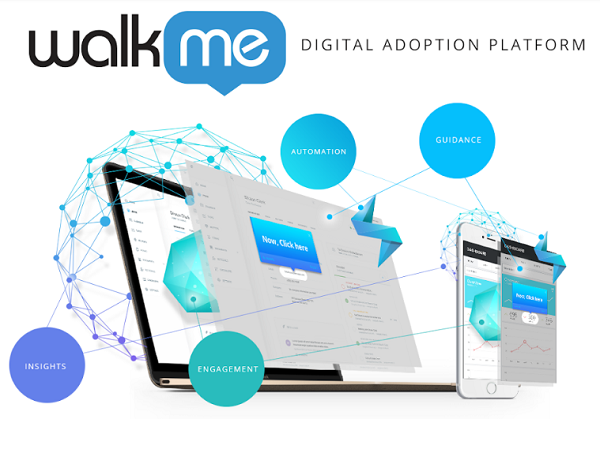

Now, in 2018, the company calls itself a “digital adoption platform,” where it simplifies the user experience on B2B applications using insights, engagement and guidance capabilities gained through machine learning and artificial intelligence.
“The idea behind digital adoption is that when you look at any platform that you have, there are so many capabilities in there, but we, as humans, are not able to adapt to all of them and do not use all of them. In fact, we use a very small minority of these things that we can do with any given application,” Rephael Sweary, co-founder and president of WalkMe, told me in an interview.
“Recently, with the digital adoption platform, what we’re trying to do is understand the gap between the capabilities of the software. What can the software do and what is the user actually doing? And what is the user actually using? And what is he doing frequently? And where can we find efficiency there? And where can be take friction out?”
A big part of finding those efficiencies has to do with machine learning and artificial intelligence, which can more easily identify how different people may be using it, providing further insights into what they need help with.
That’s why, on Wednesday, the company announced the acquisition of DeepUI, a company that developed a machine learning algorithm to understand any business software at the graphical user interface level.
No financial terms of the deal were disclosed, but it was revealed to me that DeepUI’s entire 10 person team, including co-founders Dr. Ron Zohar and Moran Shemer, began working at WalkMe in late May, and that the company has begun to absorb DeepUI’s technology onto the WalkMe platform.
“What DeepUI brought to us is a deep learning algorithm that understands any given digital platform. It could be a desktop application, it could be a Web application or a mobile application; by deep learning it, and by crowdsourcing data and usage data, we can keep on improving and improving of our understanding of what the underlying digital platform can do,” said Sweary.
The impact on WalkMe, he told me, will especially be felt in digital applications that have frequent software releases.
“Think about digital platforms that are using enterprises that are coming in a SaaS model. They have very frequent changes, sometimes even continuous development, so there isn’t really a version, you keep on getting new instances. If you customized on the user level, so, for example, you can go on a platform like Salesforce and, on top of what your organization has done, you can further do customization based on your personal preference. A lot of us don’t use it, but it is used. These are the extreme cases where the deep learning algorithm give us a very significant advantage over what we had before,” he said.
“They’re not a big team, but they’re very experienced in those types of algorithms. What they’re already doing for WalkMe is they’re taking their algorithm and starting to put it in parallel to our algorithm. So we have two algorithms working at the same time, and, so far, the benchmarks have surpassing our expectations.”
Going forward, WalkMe may also use some of DeepUI’s interfaces, such as being able to active a digital application through voice, though Sweary believes this kind of technology won’t be widely adopted in the enterprise for another few years.
“The biggest thing is really our technology, it will be easier for us to develop faster for all digital platforms. Before we had different types of algorithms for different types technologies. The way theirs works is that there is one algorithm that is able to work on all technologies. It’s mainly a back server type effect. Our customers will also feel that it’s easier to create content with the WalkMe platform. As it is WalkMe is very easy, but we’ll make it even simpler,” he said.
This is WalkMe’s third acquisition; it previously acquired native mobile AI startup Abbi in January 2017, and visual analytics startup Jaco in April 2017.
The impact of machine learning
By adding DeepUI’s machine learning capabilities to WalkMe, it will help the company gain much deeper insights into how different users are using the platform, allowing WalkMe to give them a more personalized experience.
“A typical user would be different in different contexts. For example, if I’m roaming, I’m not the same type of user when I’m not roaming and I’m on WiFi. Whether your battery is about to run out, or you have full battery, also makes you a different user. There are hundreds of permutations taken into account in a user’s journey, that are not related, necessarily, to the digital platform itself, but to the context of the user: where he is, is he rushed, is he stressed,” said Sweary.
The machine learning and artificial intelligence can be used to understand the currently context in which the user is accessing the app, and how that context affects usability. The technology can also be used to take analytics and gain a deeper understanding of what is happening on a specific site and why.
“Let’s say there is a web form in a CRM, and let’s assume in this CRM specific form there is a 7 percent error rate. That is something you can measure with analytics. What the machine learning will do is it will start tracking and understanding what causes this error rate. It might find that users from a certain browser the error rate is 100 percent. So a malfunction in that specific form when you access it from Internet Explorer 10. Or it might be users in Germany who are having trouble because they can’t process the zip code,” he said.
“Those are the types of things that trying to use analytics to find is like a needle in a haystack, but when the machine learning works it goes and brings you those actionable things that you can actually work on and fix.”
Ultimately, machine learning will have an impact on employee productivity thanks to these insights.
“The productivity acceleration for employees is pretty significant, and what we see is being able to shave between one and a half to four hours per week of daunting tasks that they do on their error messages that they get. So that’s pretty significant. With the addition of DeepUI, I believe we will be able to increase that number in a faster way, especially because of the ability to understand cross application usage, meaning when you use a couple of applications to perform one task,” he said.
“Companies today invest between $4,000 to $12,000 per employee per year on software, and a lot of this software is underutilized. We see huge impact by helping companies better utilize their software and their data validation.”
What’s next for WalkMe?
WalkMe currently has over 1,500 logos, where one logo can house more than one company. It has raised over $167 million in funding, it has over 600 employees and it is continuing to grow quickly.
So what’s next for the company? In the long run, WalkMe wants to fulfill its vision of reversing the way humans interact with their apps by having the app understand the user, not the other way around.
“The relationship between digital applications to a user today is that the user needs to understand how to operate the digital platform. Think even about the simplest digital watch, when you want to change the date or adjust the time, you need to figure out, ‘I need click this button and that button, and there is a sequence have to repeat.’ This is on everything. Notice that when you use software, you lean forward, you don’t lean backward. Why? Because you’re trying to understand what needs to be done,” Sweary said.
“WalkMe’s vision is to reverse that. Let’s have the digital application understand the user. The understanding comes from the WalkMe layer that sits on top of the digital application. We’re there, we are able to understand what is the intention of the user, what he’s trying to do, what he’s doing wrong, and assist him in a way he doesn’t even realize that he gets assistance. Really reversing the relationship between digital and human. Digital will understand the human, instead of the human understanding digital.”
In the short run, though, WalkMe is gearing up for something more tangible: a potential public.Though there aren’t definite plans for that right now, Sweary says it could come as early as next year.
“The decision on when to go public, there’s a few factors you take into account including market, timing, and other things that are relating to our strategy. So if you still have significant investments ahead of you, you might want to do them before you go public, when you have some more visibility to their success or not success. For example, penetrating a new market. You don’t want to impact your first few quarter, which are critical.”





















